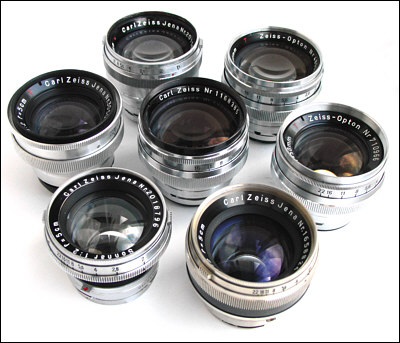
Prewar and postwar Sonnars.
From upper left: East German Jena
coated
f/2.0; wartime coated Jena f/1.5; postwar Zeiss-Optons f/1.5
and f/2.0;
coated Jena f/2.0 (possible aftermarket coating), prewar
uncoated
collapsible Jena f/2.0. Center: coated Carl Zeiss f/1.5.
The Contax Lenses
There are roughly four groups of Zeiss lenses for the Contax rangefinder. This doesn't include the Nikon or newer Cosina-Voigtlander lenses. It gets a bit complicated, so read carefully:
• Prewar Carl Zeiss Jena: These lenses were made at the Carl Zeiss factory in Jena. For the most part, these are uncoated lenses, although there are samples available with single coatings, as Zeiss was known to be developing lens coatings prior to and during World War II. There were two groups of lenses: Those developed for the original Contax (now known as the Contax I), and those for the Contax II. The Contax I lenses usually are in heavy nickel mounts, often with a black ring or painted mostly black. The Contax II lenses, for the most part, are in heavy chrome mounts. Both of these groups of lenses are heavy. Prewar lens focal lengths were marked in centimeters.
• Postwar Carl Zeiss Jena: This is where things get confusing for the beginning Contax fan. The Jena factory was located in what became the Soviet-occupied Eastern Zone of post-World War II Germany. When Carl Zeiss Jena began producing lenses, it used aluminum mounts, whose condition today is uncertain after more than 50 years. Carl Zeiss Jena lenses carry a red "T," which indicated that the lens is coated. This is how you can identify the East German lens. For the wide-angle or telephoto lenses, make sure they focus smoothly, as the helical sometimes can bind. The focal lengths tend to be marked in millimeters.
 • Postwar Zeiss-Opton: After
World War II, Carl Zeiss moved lens production to Oberkochen. These lenses,
with updated lens designs, sit in medium-weight chrome mounts and are usually
-- although not always -- marked
with a red "T." Note that the Biogon at right uses a different
symbol. Some of the lenses have black filter rings or "noses," while
many have chrome filter rings. The focal lengths are
marked in millimeters.
• Postwar Zeiss-Opton: After
World War II, Carl Zeiss moved lens production to Oberkochen. These lenses,
with updated lens designs, sit in medium-weight chrome mounts and are usually
-- although not always -- marked
with a red "T." Note that the Biogon at right uses a different
symbol. Some of the lenses have black filter rings or "noses," while
many have chrome filter rings. The focal lengths are
marked in millimeters.
• Postwar Carl Zeiss: The last group of Contax lenses were marked Carl Zeiss -- without a red "T." These generally had a black filter ring and were set in chrome mounts, and the lenses often have held up very well over the years. The focal lengths are marked in millimeters. The Carl Zeiss lenses represented the final optics that were produced for the Contax rangefinder.
 What
confuses users the most is the Carl Zeiss Jena vs. Carl Zeiss Jena "T." The
issue of West Germany's Carl Zeiss vs. East Germany's Carl Zeiss Jena
eventually was settled in a courtroom. But for the Contax user, if you see Carl Zeiss Jena, a red "T" and
an aluminum mount, it's
almost certainly East German. So skip the aluminum and go for the chrome.
The chrome lenses will always feel heavy, while East German lenses feel
light. Remember that the standard lens has no helical, because the focusing
mechanism is built into the Contax body.
What
confuses users the most is the Carl Zeiss Jena vs. Carl Zeiss Jena "T." The
issue of West Germany's Carl Zeiss vs. East Germany's Carl Zeiss Jena
eventually was settled in a courtroom. But for the Contax user, if you see Carl Zeiss Jena, a red "T" and
an aluminum mount, it's
almost certainly East German. So skip the aluminum and go for the chrome.
The chrome lenses will always feel heavy, while East German lenses feel
light. Remember that the standard lens has no helical, because the focusing
mechanism is built into the Contax body.
In general, the coated lenses will perform better than the uncoated lenses, producing higher contrast. In use, I think you'll be satisfied with any of the prewar or postwar Carl Zeiss lens, whether it be East or West German. The West German lenses certainly feel better made. And if you buy a non-50mm East German lens, make sure it focuses smoothly.
There also seems to be a lot of Russian glass out there, but I've read that you can't always be assured of getting a good lens. That's up to you.
Quick comments on specific lenses.
